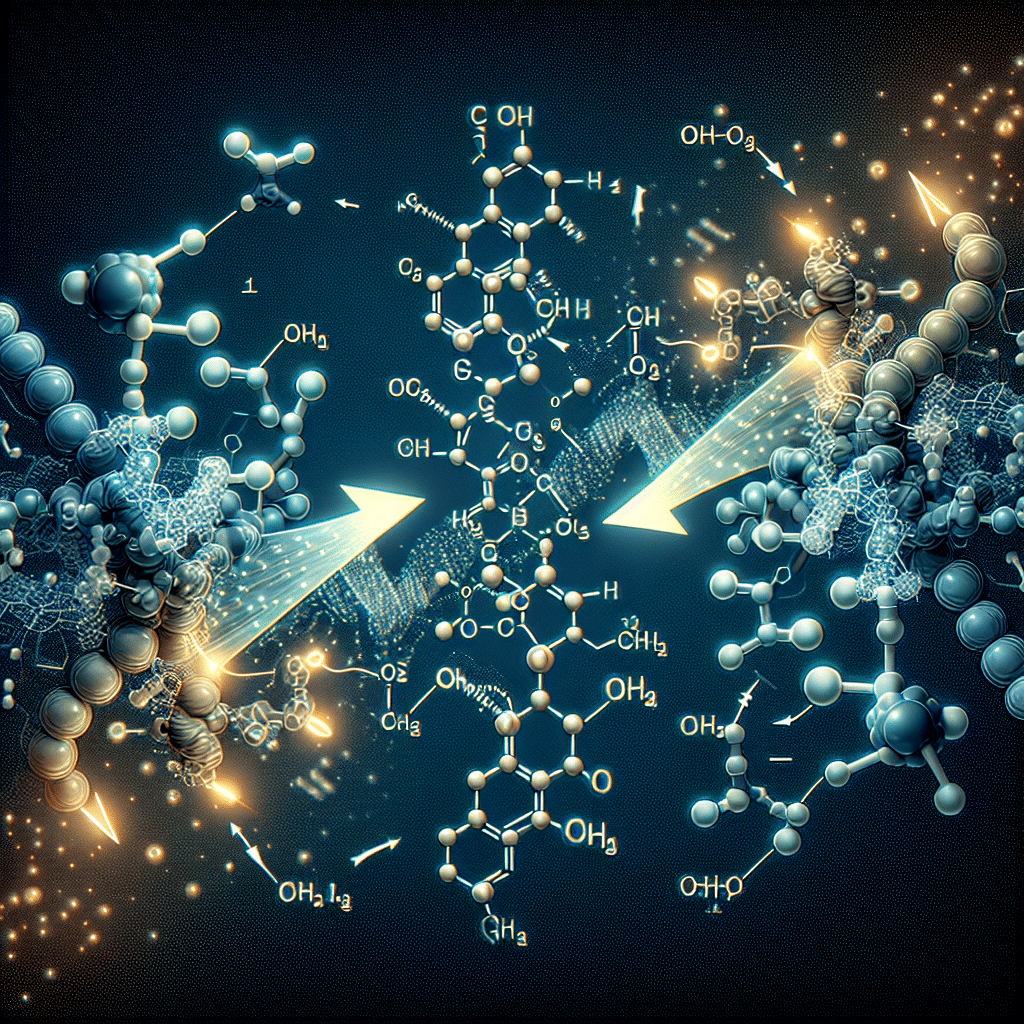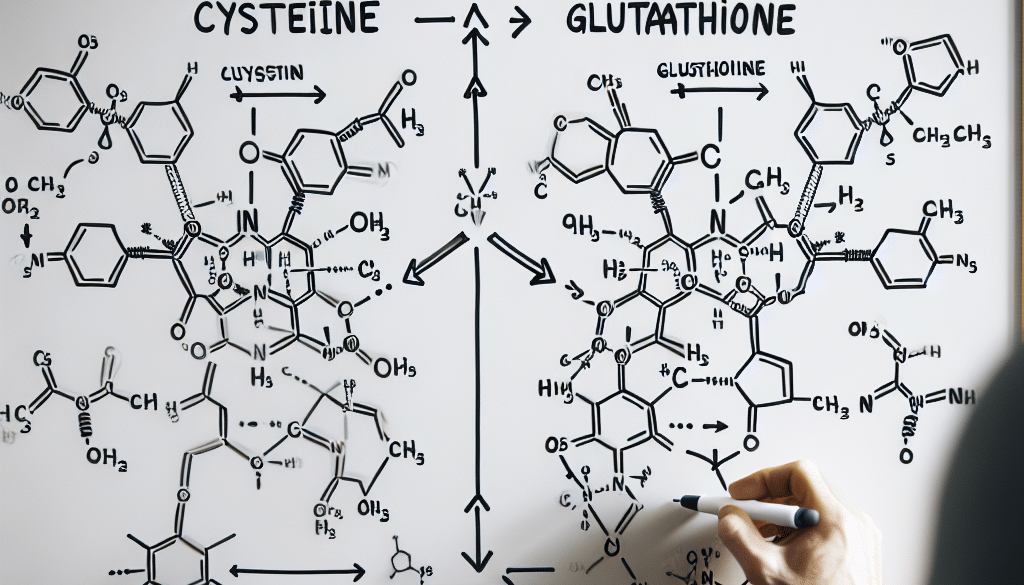Crosstalk Between Cysteine and Glutathione: Explained
-
Table of Contents
- Understanding the Crosstalk Between Cysteine and Glutathione
- The Vital Roles of Cysteine and Glutathione
- Cysteine: A Building Block and Antioxidant
- Glutathione: The Master Antioxidant
- Interplay Between Cysteine and Glutathione Synthesis
- Factors Influencing Cysteine and Glutathione Levels
- Antioxidant Defense and Redox Balance
- Glutathione’s Role in Redox Homeostasis
- Implications of Disrupted Redox Balance
- Case Studies and Research Findings
- Statistical Evidence of Benefits
- Conclusion: Key Takeaways on Cysteine and Glutathione Crosstalk
- Discover ETprotein’s High-Quality Protein Products
Understanding the Crosstalk Between Cysteine and Glutathione

The intricate dance between cysteine and glutathione within the human body is a testament to the complexity of biological systems. These two molecules play critical roles in maintaining cellular health and protecting against oxidative stress. This article delves into the crosstalk between cysteine and glutathione, exploring their functions, interdependence, and the implications for human health.
The Vital Roles of Cysteine and Glutathione
Cysteine and glutathione are sulfur-containing molecules that are pivotal in various biochemical pathways. Cysteine is an amino acid that serves as a building block for proteins, while glutathione is a tripeptide composed of cysteine, glutamate, and glycine. Together, they are involved in detoxification processes, antioxidant defense, and the regulation of cellular redox states.
Cysteine: A Building Block and Antioxidant
- Cysteine is a semi-essential amino acid, meaning it can be synthesized by the body under normal physiological conditions.
- It is a precursor to proteins, coenzymes, and other important molecules like taurine and coenzyme A.
- Cysteine contains a thiol group, which can act as an antioxidant by neutralizing free radicals.
Glutathione: The Master Antioxidant
- Glutathione is often referred to as the “master antioxidant” due to its central role in the body’s antioxidant defense system.
- It participates in the detoxification of harmful substances, including drugs and environmental toxins.
- Glutathione is also involved in the maintenance of other antioxidants, such as vitamins C and E, in their active forms.
Interplay Between Cysteine and Glutathione Synthesis
The synthesis of glutathione is heavily reliant on the availability of cysteine. The rate-limiting step in glutathione synthesis is the enzyme glutamate-cysteine ligase (GCL), which combines cysteine and glutamate. This dependency underscores the importance of cysteine in maintaining adequate levels of glutathione within cells.
Factors Influencing Cysteine and Glutathione Levels
- Dietary intake of cysteine-rich foods, such as poultry, eggs, and garlic, can affect glutathione synthesis.
- Metabolic demands and stressors, such as illness or exercise, can deplete glutathione stores, increasing the need for cysteine.
- Genetic variations in enzymes related to glutathione metabolism may influence individual levels of these molecules.
Antioxidant Defense and Redox Balance
The crosstalk between cysteine and glutathione is crucial for maintaining the delicate balance between oxidation and reduction (redox) within cells. Glutathione exists in two forms: the reduced form (GSH) and the oxidized form (GSSG). The ratio of GSH to GSSG is often used as an indicator of cellular oxidative stress.
Glutathione’s Role in Redox Homeostasis
- Glutathione directly neutralizes reactive oxygen species (ROS) and reactive nitrogen species (RNS).
- It regenerates other antioxidants, such as vitamin C, back to their active forms after they have been oxidized.
- Glutathione is involved in the repair and synthesis of DNA, protein synthesis, and amino acid transport.
Implications of Disrupted Redox Balance
- Oxidative stress resulting from an imbalance in redox homeostasis can lead to cellular damage and contribute to the development of chronic diseases.
- Conditions such as cancer, cardiovascular disease, and neurodegenerative disorders have been linked to oxidative stress and impaired glutathione metabolism.
- Enhancing cysteine and glutathione levels through dietary supplementation or lifestyle changes may offer therapeutic potential.
Case Studies and Research Findings
Research has provided insights into the relationship between cysteine and glutathione levels and various health outcomes. For instance, studies have shown that individuals with HIV/AIDS have lower levels of cysteine and glutathione, which may contribute to the progression of the disease. Supplementation with N-acetylcysteine (NAC), a cysteine donor, has been found to boost glutathione levels and improve immune function in these patients.
Statistical Evidence of Benefits
- A meta-analysis of clinical trials indicated that NAC supplementation could significantly reduce the risk of exacerbations in patients with chronic obstructive pulmonary disease (COPD).
- Another study found that glutathione levels were inversely associated with the risk of cardiovascular events, suggesting a protective role for this antioxidant.
- Research in the field of oncology has explored the use of cysteine and glutathione modulators to enhance the efficacy of chemotherapy and reduce its toxicity.
Conclusion: Key Takeaways on Cysteine and Glutathione Crosstalk
The crosstalk between cysteine and glutathione is a fundamental aspect of cellular health, influencing detoxification, antioxidant defense, and redox balance. Adequate levels of cysteine are essential for the synthesis of glutathione, which in turn protects cells from oxidative damage and supports various physiological processes. Understanding this interplay can inform strategies to enhance health and combat diseases associated with oxidative stress.
Discover ETprotein’s High-Quality Protein Products
For those looking to support their health with high-quality protein products, ETprotein offers a range of options. Their products, including organic rice protein, pea protein, and various seed proteins, provide essential amino acids like cysteine that are crucial for glutathione synthesis and overall well-being. Additionally, ETprotein’s L-(+)-Ergothioneine (EGT) supplements offer another layer of antioxidant support, contributing to the body’s defense against oxidative stress.
About ETprotein:
ETprotein, a reputable protein and L-(+)-Ergothioneine (EGT) Chinese factory manufacturer and supplier, is renowned for producing, stocking, exporting, and delivering the highest quality organic bulk vegan proteins and L-(+)-Ergothioneine. They include Organic rice protein, clear rice protein, pea protein, clear pea protein, watermelon seed protein, pumpkin seed protein, sunflower seed protein, mung bean protein, peanut protein, and L-(+)-Ergothioneine EGT Pharmaceutical grade, L-(+)-Ergothioneine EGT food grade, L-(+)-Ergothioneine EGT cosmetic grade, L-(+)-Ergothioneine EGT reference grade and L-(+)-Ergothioneine EGT standard. Their offerings, characterized by a neutral taste, non-GMO, allergen-free attributes, with L-(+)-Ergothioneine purity over 98%, 99%, cater to a diverse range of industries. They serve nutraceutical, pharmaceutical, cosmeceutical, veterinary, as well as food and beverage finished product distributors, traders, and manufacturers across Europe, USA, Canada, Australia, Thailand, Japan, Korea, Brazil, and Chile, among others.
ETprotein specialization includes exporting and delivering tailor-made protein powder and finished nutritional supplements. Their extensive product range covers sectors like Food and Beverage, Sports Nutrition, Weight Management, Dietary Supplements, Health and Wellness Products, and Infant Formula, ensuring comprehensive solutions to meet all your protein needs.
As a trusted company by leading global food and beverage brands and Fortune 500 companies, ETprotein reinforces China’s reputation in the global arena. For more information or to sample their products, please contact them and email sales(at)ETprotein.com today.














